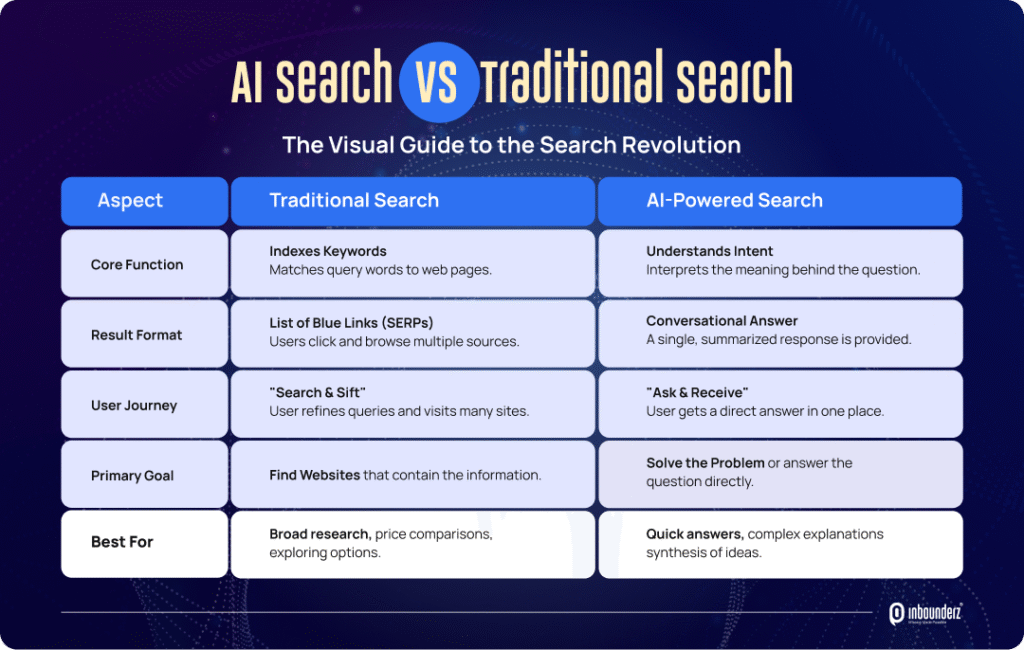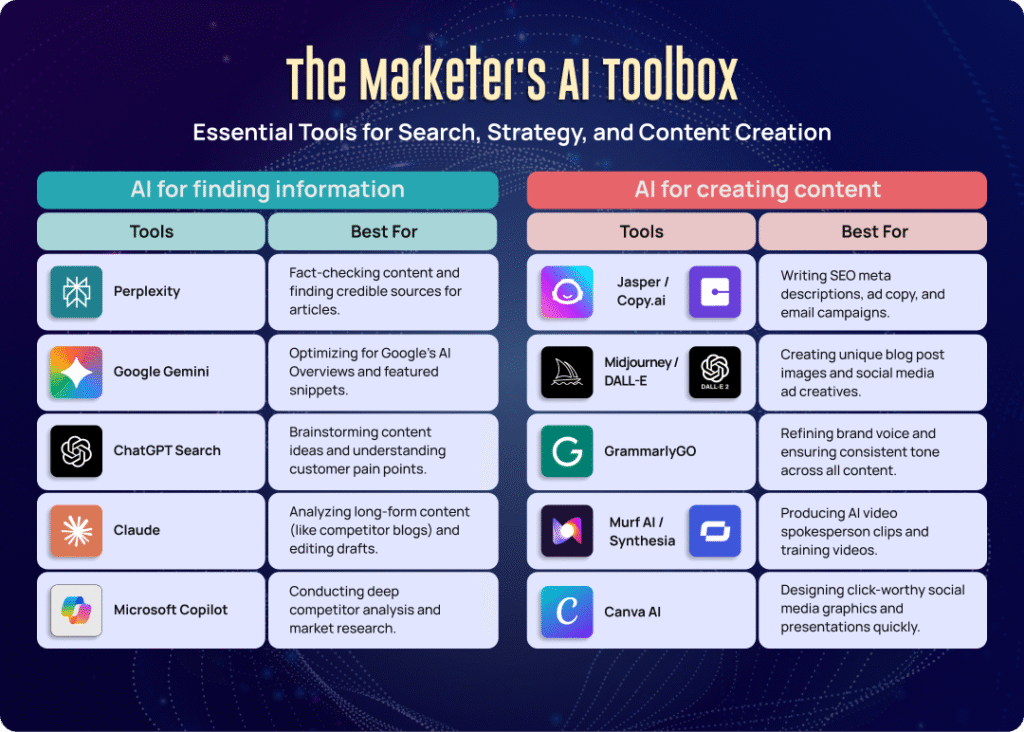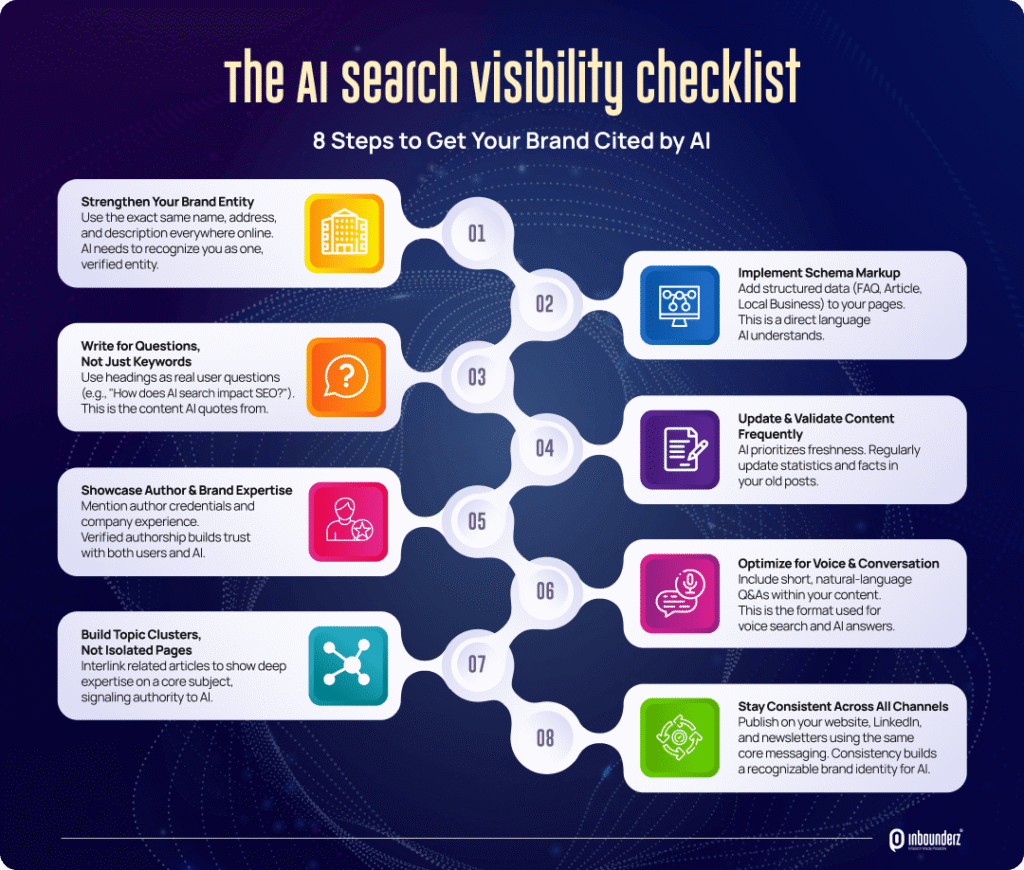The Search Shift Marketers Can’t Ignore
A few years ago, “Google it” was the default response to every question. Today, that habit is quietly fading. Many consumers now turn to AI search engines such as ChatGPT, Gemini, Perplexity, and Grok to ask full questions and receive direct, conversational answers.
This marks the arrival of AI‑powered search, a new way of discovering information where people expect one accurate summary instead of scrolling through a list of links. What feels effortless for users is transforming how marketers think about visibility and discovery.
For brands, the challenge is clear. It is no longer only about ranking on Google but about being recognised and trusted by machines that generate those answers.
This blog explains how AI search is reshaping consumer search behaviour, why people are shifting from traditional search engines to AI‑driven tools, and what AI SEO strategies marketers need to stay visible and relevant in 2025 and the years to come.
What This Means for Marketers: Search hasn’t disappeared; it has simply learned how to talk back.
Understanding the Rise of AI Search Engines
The way people look for information is no longer limited to traditional search engines. AI search engines have changed what users expect from a search experience.
Instead of typing keywords and sorting through a results page, users now ask questions in natural language and receive direct answers that combine data, reasoning, and context. This approach offers a smoother search journey with faster decisions.
Why this matters:
- AI search focuses on conversation, intent, and relevance, not just matching keywords.
- Results appear as summaries or recommendations generated from trusted information.
- Users spend less time clicking links and more time relying on AI‑powered answers.
- The most cited sources come from well‑structured, verified, and updated websites.
What to Note: AI search engines are teaching consumers to value precise, conversational answers over long lists of links and ads.
The Big Players in AI Search
These platforms are shaping how modern users discover ideas, products, and services:
| AI Tool | Core Function | Why It Matters to Marketers |
| ChatGPT Search / Copilot | Conversational Q&A with live web access. | Encourages natural‑language content and fact‑based writing. |
| Google Gemini / AI Overview | Adds AI summaries to traditional results. | Rewards structured data and clear context. |
| Perplexity AI | Provides referenced answers from verified sites. | Boosts the value of factual, well‑cited pages. |
| Grok | Pulls insights from social platforms, mainly X (Twitter). | Social mentions and brand presence become SEO signals. |
| You.com / Claude for Search | Combine productivity tools with AI discovery. | Expands visibility for niche or long‑form educational content. |
What This Means for Marketers: The search competition is no longer between websites, but between the brands that AI chooses to trust and quote
To learn how different AI platforms influence campaigns and decision‑making, read Boost Your Google Ads ROI: Best AI Tools and Strategies.
How AI Has Changed Consumer Search Behaviour
AI search engines have completely changed the way people look for information online.
Instead of scanning pages of results, consumers now engage with AI‑powered search through full sentences and natural conversations. The focus has moved from finding links to getting ready‑made answers.
What Has Changed in User Behaviour
- Conversational queries: People speak to search tools as they would to an assistant. Example – “Which digital marketing agency in Bangalore specializes in AI SEO?” instead of simply typing “best SEO agency Bangalore.”
- Zero‑click decisions: Users rely on summary answers from AI search engines like ChatGPT and Gemini without visiting websites.
- Personalized journeys: Each response is generated according to a person’s previous questions, tone, or intent.
- Faster trust formation: When a model repeatedly cites specific brands or sources, consumers begin to trust them more than traditional ads.
- Voice and visual integration: Many now use voice search or upload images to get context‑based responses.
What to Note: AI search has made information consumption simpler for users , but more competitive for brands trying to stay visible.
Real‑World Example
Imagine a business owner planning a quick marketing campaign. Instead of opening Google, they ask Perplexity, “Which digital marketing agency in Bangalore offers AI‑driven strategies?”
Within seconds, they receive a concise summary listing a few top agencies with supporting links and context; no browsing through multiple pages.
This single act reflects the broader AI search vs traditional search shift: fewer clicks, faster answers, smarter decisions.
It also repeats the pattern we explored in How AI Chatbots Are Transforming the Future of Customer Engagement, where AI systems are taking over direct conversations with customers and reshaping user expectations.
AI Search vs Traditional Search – A Closer Look
Search is no longer a competition of keywords; it is now a contest of context. The difference between AI search engines and conventional search platforms defines how brands, marketers, and consumers interact online.
- How Traditional Search Engines Work
- Built around keyword indexing and the authority of backlinks.
- Users refine several queries to reach one useful result.
- Visibility depends on content optimisation, page load, and link quality.
- Ads often dominate the first few results, creating distractions.
Traditional search is reliable but reactive. Here, users must know what they’re looking for before typing it.
- How AI‑Powered Search Engines Think
- Operate through natural language processing and context awareness.
- Understand intent and produce human‑like responses rather than lists of links.
- Blend information from multiple sources and summarise key insights.
- Examples include Claude AI, You.com Search, and Komodo AI, which combine conversation with quick fact checks.
AI systems interpret meaning like a discussion, not a database query.

- Competitive Advantages of AI Search
| Area | How AI Search Performs Better |
| Speed | Delivers results faster and with fewer steps. |
| Precision | Understands the tone of the query and adjusts replies accordingly. |
| Personalisation | Learns from previous interactions to curate answers. |
| User Experience | Provides summaries, voice, and image support in one response. |
For marketers, this personalised and conversational approach translates into a new kind of visibility: being featured within an AI summary rather than simply ranking on a results page.
- Drawbacks and Limitations
- AI systems can misinterpret context or provide incomplete information.
- Limited transparency about sources may obscure credibility.
- Over‑personalisation can restrict exposure to new ideas or brands.
- Many platforms are still improving data freshness and localisation.
What This Means for Marketers: AI search is faster and more intuitive, but standing out requires structured data and a trusted digital footprint across multiple AI platforms.
How Traditional Engines Are Responding
Search giants are adapting very quickly.
- Google integrates generative responses through its AI Overview, blending summaries with cited links.
- Microsoft Bing Copilot merges conversational AI with enterprise‑level search tools.
- Smaller engines such as Neeva AI and Andi Search highlight transparency and source references to regain trust.
Traditional search is becoming more interactive, using AI features to stay relevant in a market that’s now shaped by intelligent assistants.
To learn how these changes already influence ad visibility and keyword bidding, see Boost Your Google Ads ROI: Best AI Tools and Strategies.
(Infographics)
Why the Shift Happened – What’s Behind the Change
The transition from traditional search engines to AI‑powered search did not happen overnight. It shows years of frustration with cluttered results, heavy advertising, and irrelevant recommendations. Consumers simply found a faster, easier way to search.
Main Reasons Driving the Shift
- Convenience and speed
AI search tools reduce the number of steps needed to reach an answer. People now expect search to feel like a conversation, not a task.
- Personalization
Generative AI platforms study previous queries and behaviour patterns to deliver more relevant
responses than traditional engines.
- Trust in contextual summaries
Users trust the reasoning that AI provides behind each result instead of sifting through endless links. This supports the same logic we discussed in Convert More Visitors: 11 Costly Website mistakes to Fix Now. People engage longer with content that feels clear and credible.
- Reduced information overload
People prefer a single answer that feels complete instead of multiple tabs and pop‑ups. AI summaries cut noise and save time.
- Integration with daily technology
Voice assistants, mobile widgets, and smart devices uses AI search by default. The shift from typing to asking is subtle but constant.
What This Means for Marketers: The move towards AI search is fueled by consumer demand for speed and clarity. Marketers must meet that expectation with content that answers directly and feels authentic.
The Advantages and Disadvantages of AI Tools in Search
Every new technology brings both progress and pressure, and AI‑powered search is no exception. Its biggest strength is personalization, while its greatest risk is information bias. Understanding both sides helps marketers refine their content strategies.
Advantages of AI Search Tools
- Smarter Personalization
AI search engines learn from past queries to deliver answers that match intent and tone. This precision is accelerating AI SEO adoption because content now needs to serve real-time, context-based needs.
- Faster, Simpler Experiences
AI summaries remove the need for multiple clicks or long scrolls, saving users time and increasing trust. - Better Engagement Through Conversation
Tools like Claude, You.com, and Komodo AI encourage users to continue the dialogue, keeping search interactive and dynamic.
- Voice and Visual Integration
The rise of voice search and image‑based queries adds new opportunities for brands to be discovered through different formats.
- Higher Content Visibility for Quality Sources
Credible, up‑to‑date pages are more likely to appear in AI summary answers, providing long‑term
authority that traditional SEO alone cannot deliver. This ties into Boost Your Google Ads ROI: Best AI Tools and Strategies , where smart automation already improves targeting accuracy.
Disadvantages and Challenges
- Partial or Inaccurate Information
AI summaries sometimes miss context or over‑generalize complex data points.
- Limited Transparency of Sources
Many AI platforms don’t clearly show where their answers come from, making it difficult for
marketers to trace citations.
- Reduced Organic Traffic to Websites
As users get answers directly within AI search interfaces, fewer click through to sites even when
brands are cited.
This reduces organic traffic to websites and creates the need for new visibility metrics beyond page views.
- Over‑Reliance on Algorithm Training Data
Bias in training data can decide which brands AI search recommends, limiting fair competition. - High Adaptation Cost for Marketers
Teams must learn AI SEO principles and update content frequently to stay included in fresh training cycles.
What This Means for Marketers: AI search opens new doors for visibility, but brands must focus on accuracy and continuous optimization to avoid being filtered out by smart algorithms.
Impact on Marketers and Businesses
The shift to AI‑powered search has redefined how visibility and trust are built online. Traditional search metrics such as clicks, impressions, or keyword rankings are no longer enough. What matters now is how often a brand is recognized, referenced, and summarized by AI search engines.
Key Impacts Marketers Should Understand
- Decline in Organic Traffic
Zero‑click searches mean that users often get everything they need directly from AI summaries. Even if a website is cited, fewer users click through to open it. The challenge for marketers is to measure success beyond visits and focus more on visibility within AI‑generated answers.
- Rise of Entity‑Based SEO
AI search engines are context‑driven, valuing accuracy and authority over keyword density. Brands now need consistent details across digital listings, schema markup, and content clusters to help AI systems clearly identify who they are and what they do. - Higher Demand for Authoritative Content
AI assistants favour fact‑checked information that demonstrates expertise. Blogs and landing pages written by specialists and backed by data are more likely to appear within AI summaries. This emphasis brings credibility but also raises competition for authenticity.
- Changing Paid Search Models
As generative interfaces limit the space for ads, marketers must rethink PPC and campaign application. Smart automation, predictive targeting, and adaptive copywriting will be essential for AI‑driven visibility. You can see practical approaches to this adjustment in Boost Your Google Ads ROI: Best AI Tools and Strategies. - New KPIs and Performance Metrics
Instead of only tracking website traffic, teams should monitor how frequently their brand is mentioned or cited inside AI results. Terms such as AI presence, brand citation, and summary mention frequency are quickly replacing traditional metrics in modern dashboards.
What This Means for Marketers: Success in AI search is no longer about getting more clicks but about
building a digital identity that AI can easily recognize and recommend.
Best Practices to Appear in AI Search Results
Standing out in AI‑driven search is not about chasing algorithms anymore. It is about shaping content that machines can understand and users can trust.
Practical Steps Every Brand Should Follow
- Strengthen Brand Entities
Keep the same name, address, and description on every digital platform. AI systems connect these signals to recognize your brand as a single verified entity. - Use Structured Data and Schema
Add schema for articles, FAQs, and local business pages. It helps AI search engines read your content correctly and display it in conversational answers. - Write for Questions, Not Keywords
Frame headings as real user questions like “How does AI search impact SEO?” or “What is zero‑click behaviour?” These prompts make it easier for AI to quote your content directly. - Update and Validate Content Frequently
AI search tools weigh freshness and relevance heavily. Review statistics, rewrite old posts, and keep your sources factual. - Highlight Author Credibility and Experience
Mention writer roles or company expertise to enhance trustworthiness. Verified authorship and real insights improve how AI models assess content quality. - Optimize for Voice and Conversational Search
Add short, natural‑language answers for each sub‑topic. AI assistants use these snippets to respond to voice queries instantly. - Create Content Clusters Around Core Topics
Interlink related posts to show topical depth. For example, connect this article to How AI Chatbots Are Transforming the Future of Customer Engagement to reinforce your authority in AI‑driven communication. - Stay Consistent Across Channels
Publish insights on LinkedIn, the company website, and newsletters using a similar tone and terminology. Consistency builds recognition, improving your position in conversational engines.
What This Means for Marketers: Visibility in AI search is built on clarity and credibility. Your goal is to make answers easy for machines to read and trust.
Inbounderz’ Perspective – Strategy for the AI Search Era
At Inbounderz, we view AI search as both a challenge and an opportunity. The challenge lies in the constant evolution of algorithms that learn faster than most brands can adapt. The opportunity lies in understanding how these systems rank, extract, and cite reliable information, and preparing businesses to become part of those trusted answers.
How Inbounderz Approaches AI Search Optimization
- Entity‑Focused Content Framework
We build content that helps AI understand the brand and what it represents. Each project begins with entity auditing and schema alignment so that search systems recognize our clients as reliable sources. - Conversational and Voice Optimization
Content is designed to mirror real questions that people ask on voice and chat‑based platforms. This approach improves visibility not only in AI search results but also through digital assistants and connected devices. - Data‑Driven Content Clusters
Our strategy connects service pages, blogs, and short videos within related topic clusters. These clusters signal topical authority to AI systems that now prioritize context instead of isolated pages. - Continuous Content Refresh
We run quarterly reviews to update facts, statistics, and keywords. Keeping information accurate ensures that brands remain visible to AI search tools that reward current data. - AI Performance Monitoring
We measure how often a brand appears inside AI‑generated results. Tracking citations and summary mentions provides a realistic view of search visibility.
What This Means for Marketers: Inbounderz treats AI search as a connected ecosystem, not a simple SEO update. The goal is to help brands educate machines as effectively as they communicate with people.
Challenges and Responsible Use of AI Search
While AI search has simplified how people find information, it has also introduced new challenges for both consumers and marketers. The convenience is clear, but so are the ethical and practical risks.
Key Challenges Marketers Should Recognize
- Accuracy and Transparency
AI systems sometimes present incomplete or outdated information. Marketers must verify facts before citing data generated by AI answers and ensure that their own content remains correct and consistent. - Over‑Reliance on Automation
Allowing algorithms to make all communication decisions can lead to tone or context errors. Human insight should stay central in reviewing campaigns that depend on AI output.
- Loss of Source Visibility
When AI assistants summarise content, the source often gets less attention. This can reduce traffic and limit recognition unless brands are clearly mentioned and structured for AI visibility. - Bias and Limited Data Range
AI tools learn from the datasets they are trained on. If the data lacks diversity, search results may exclude small or regional businesses. Marketers need to diversify the content they publish and partner with other credible creators to balance representation. - User Misunderstanding of AI Responses
Many consumers assume AI answers are objective truths. Businesses should encourage critical thinking by publishing educational content that explains data sources and industry context.
Takeaway for Marketers: Responsible AI use is about mixing human judgment with automation. Brands that combine accuracy, transparency, and empathy will build long‑term trust in today’s AI‑led world.
Predictions for 2025 and Beyond
The way people search will continue to evolve as AI systems mature. Below are realistic developments marketers should prepare for over the next few years.
- Search Becomes a Conversation
AI assistants will refine how they interpret questions, allowing users to ask follow‑ups within the same thread. Brand visibility will depend on how well content aligns with these conversational paths. - Rise of Voice and Visual Search
Voice‑activated tools and image‑based search options will grow faster than text queries. Marketers need to create concise, spoken‑style responses and properly tagged visuals to stay visible in that environment. - Greater Consumer Reliance on AI Summaries
People will start trusting AI over websites for product research. Clear authorship and factual validation will become essential signals that separate credible information from generic summaries. - Personalized AI Profiles
Search engines will move toward personal search identities that store user intent and history. Businesses will need flexible messaging capable of adapting to individual search journeys. - Shift in SEO Metrics
Traditional metrics such as page rank and click‑through rate will lose importance. Engagement measures that track AI citations, content mentions, and brand recall will take their place. - Collaboration Between Marketers and AI
Instead of replacing human creativity, AI will enhance it through prediction, summarization, and insight generation. Teams that balance data and creativity will lead this next phase of content strategy.
The bigger picture: AI search will not eliminate traditional methods but merge with them to form a
hybrid discovery system that values authentic brands and original knowledge.
Action Plan and Best Practices for Marketers
For marketers, staying relevant means acting early and building a clear framework for adaptation. The following checklist can guide that process.

Immediate Actions

- Audit All Existing Content
Review every blog, page, and ad copy for accuracy and context. Rewrite sections that rely solely on keywords so they answer real questions instead. - Implement Structured Data and Schema
Add schema tags for articles, local businesses, and FAQs. This improves how AI search engines read and represent your information. - Update Brand Profiles Across Platforms
Consistency in descriptions and contact details helps AI tools recognise your business as one accurate entity. - Build Topic Clusters around Focus Areas
Interlink relevant articles to display subject authority. To know more, read Convert More Visitors: 11 Costly Website Mistakes to Fix Now, which explains how on‑site structure influences user and AI understanding. - Train Teams on AI SEO and Conversation‑Friendly Writing
Encourage short, factual, and tone‑aware language that matches AI prompt styles.
On-going Practices
- Refresh and Republish
Plan quarterly updates with new data, examples, or visuals to demonstrate freshness. - Track AI Mentions and Citations
Monitor how often your content appears in AI summaries or generative answers to evaluate influence beyond regular analytics. - Encourage Transparency and Fact‑Checking
Publish verified information with clear sources to increase trust both with people and algorithms. - Combine Creativity with Evidence
Maintain storytelling, but back it with real insights and measurable results.
- Create an AI Search Readiness Calendar
Treat AI visibility as an ongoing project. Schedule content audits, training, and strategy reviews every quarter.
For marketing teams to note: AI search will continue to evolve, so maintaining consistency and trust is more valuable than chasing short‑term ranking trends.
Conclusion – Adapting to the Conversation Era of Search
Search is no longer a static results page; it has become a two‑way exchange between people and machines. AI search engines interpret questions, learn intent, and deliver answers that feel personal and immediate. For consumers, this means less effort and faster clarity. For marketers, it means a complete re‑evaluation of how information is presented and trusted online.
The teams that win in this new environment will be those that simplify their content, maintain credible data, and keep their digital presence consistent across every platform.
Performance now depends not only on search rankings but also on whether AI systems view a brand as an authentic, knowledgeable source. At Inbounderz, we believe that the future of marketing lies in education through clarity by teaching brands how to communicate with technology and helping technology understand those brands better. As AI continues to drive consumer choices, one principle will remain true - the brands that speak clearly, update consistently, and prioritise trust will always be found.



